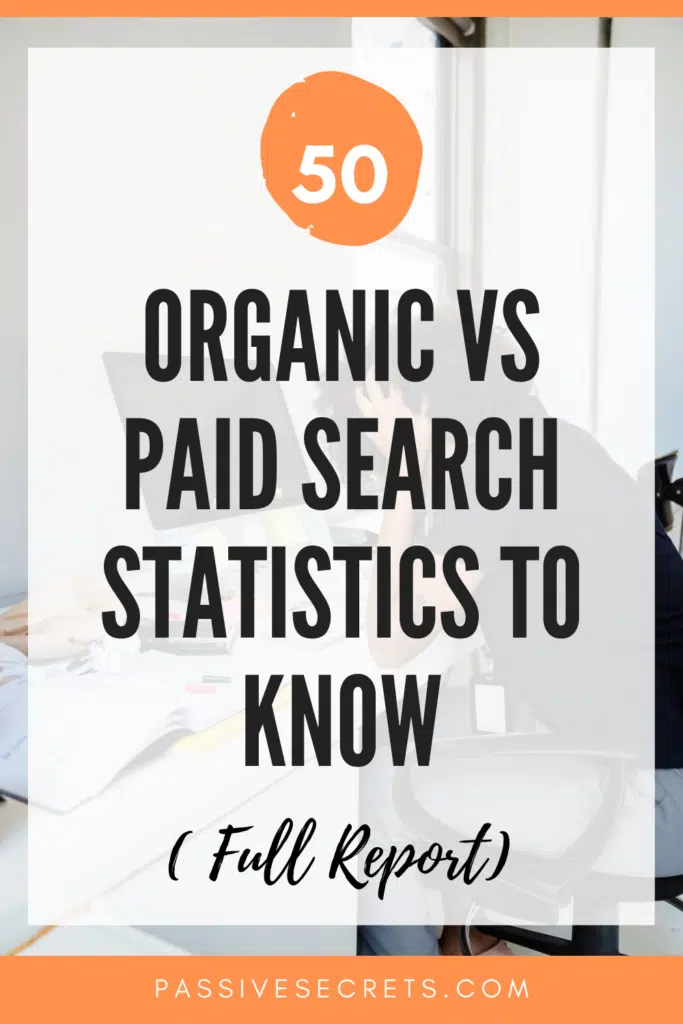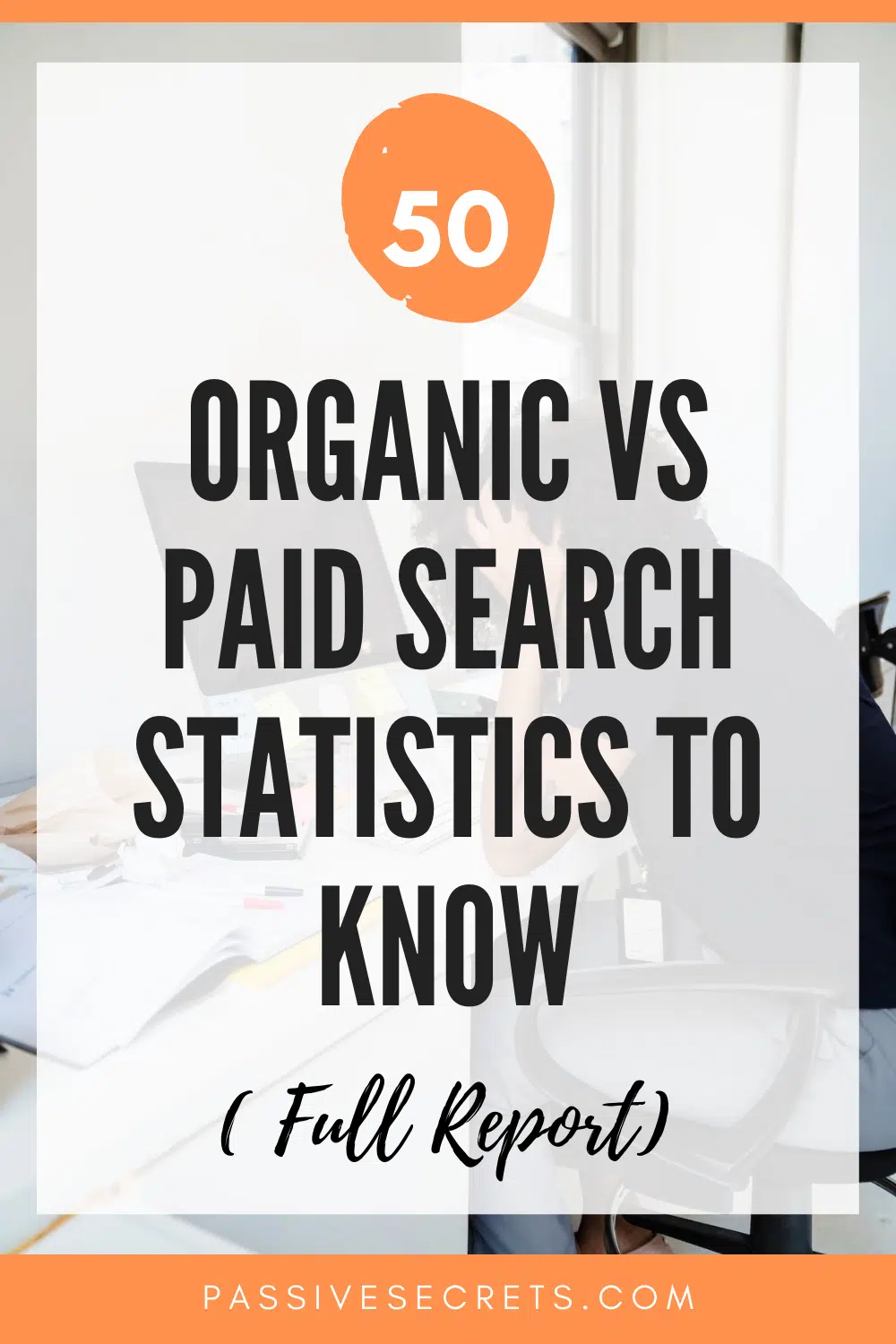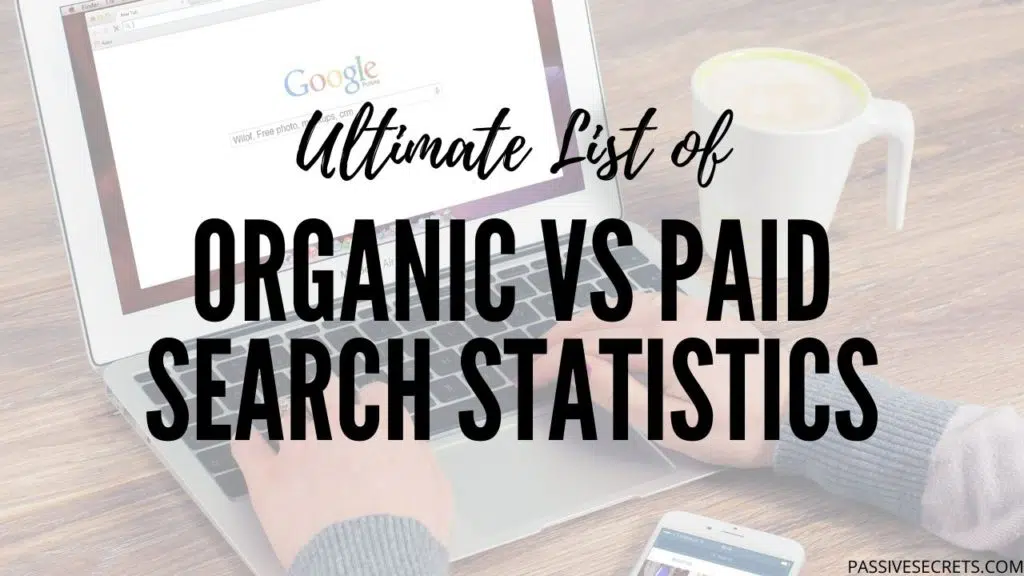
When considering search engine marketing, businesses often question whether to focus on organic or paid searches.
Both approaches have advantages and disadvantages, and the best strategy will depend on factors such as the business’s goals, budget, and target audience.
Organic search is obtained by optimizing the website and content for relevant keywords to appear at the top in the search results.
Paid search, however, entails paying for advertising space on the search engine results page.
While organic search takes time and effort, it is highly effective in the long run. Paid search, while faster, is less cost-effective.
So which is better, organic search or paid search? This is a question almost all, if not all, marketers have wondered or are still wondering.
These strategies are great, but which one gives better results?
You may have to look at the latest organic vs. paid search statistics to choose a stand.
These internet marketing strategies are so important to the success of your business because they boost your online marketing results and generate traffic to your website.
This article contains the latest organic vs. paid search statistics you must decide. This information lets you easily know and choose the best option to boost your online marketing strategy.
Difference Between Organic Search and Paid Search
According to internet live stats, over 101,000 searches on Google every second.
Organic and paid searches are strategies to boost content visibility on search engines. However, they are done in different ways. The major difference between both terms is their different approaches to generating traffic.
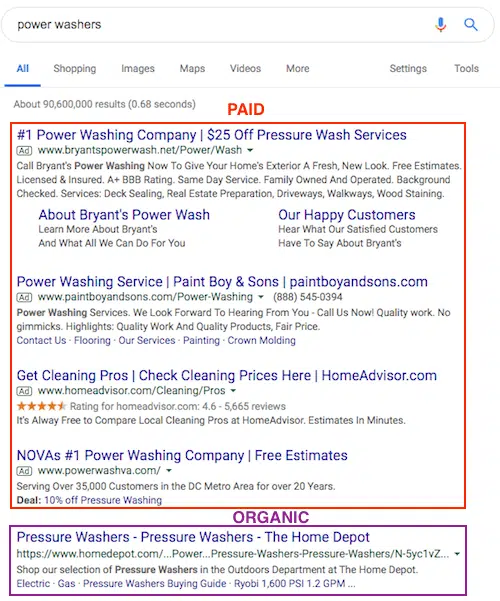
What is Organic Search (SEO)?
When we talk about organic search, what comes to mind is SEO. This is because Search Engine Optimization (SEO) plays a massive role in organic search.
Organic results appear after the ‘Ad’ results when you type in a search query on Google or any other search engine. The organic search results are displayed based on the quality and relevance of the page’s content.
Google is very particular about pushing higher-quality content.
SEO takes some time before you see results, mainly because Google has to crawl through the content on your website and index the information.
Aside from SEO, redirecting people from your social media accounts to your website is another way of generating organic traffic. But this is not as effective as SEO.
If you want your business to be considered an authority in its industry, you need to take your SEO game seriously.
Earning a top-ranking position on a search engine and increasing organic traffic takes more deliberate time and effort, but the results are long-term.
What is Paid Search (PPC)?
Companies pay search engines to appear at the top of the search results page in paid search. These results are usually tagged with ‘Ads’ and before organic search results.
Marketers usually use the paid search strategy to post an ad or create awareness for a promo sale.
Paid search is under Search Engine Marketing (SEM). SEM encompasses paid ad campaigns and the application of key performance indicators in advertising activities.
Paid search or pay-per-click (PPC) takes a short time to see results because the ads run within a period.
Most businesses prefer PPC because it is great for brand recognition. You get to generate targeted traffic and boost your ROI. However, you can only rank on top for a limited time – throughout your ad.
Simply put, SEO (organic search) and PPC (paid search) differ. SEO generates organic/natural traffic, while PPC creates traffic through paid ads.
Organic Vs. Paid Search Statistics
Organic Search Statistics
1. 64% of business marketers invest in organic search (SEO). (source)
2. 75% of marketers believe that SEO is an effective strategy to achieve their marketing goals. (source)
3. About 57% of B2B online marketers agree that SEO helps generate more leads for them than other online marketing initiatives. (source)
4. About 21% of consumers use the search engine daily to search for local businesses near them. (source)
5. As of 2020, Google accounted for 92% of the overall organic search engine visits in the United States. (source)
6. The top search results on Google’s page get about 31.7% of all clicks. Also, the top organic results are ten times more likely to get more clicks than a result in the 10th position. (source)
Most people don’t have the patience to scroll down or open as many pages as possible to find what they want.
7. 95% of search traffic happens on the first page of the search engine’s SERP. (source)
It is very rare for someone to click on the second page unless they are desperate to get information on that search query.
Instead, online users will prefer to re-enter another search query closely related to what they want to find.
8. The first five organic results on search engines account for about 67.6% of all clicks. This is more than two-thirds of all clicks. (source)
The competition to rank high is getting tougher by the day. Therefore, you need to know what works best for you and how to make the best out of it.
9. The first page results on Google’s results page have a click-through rate of 28.5%. As the position drops, the click-through rate reduces. (source)
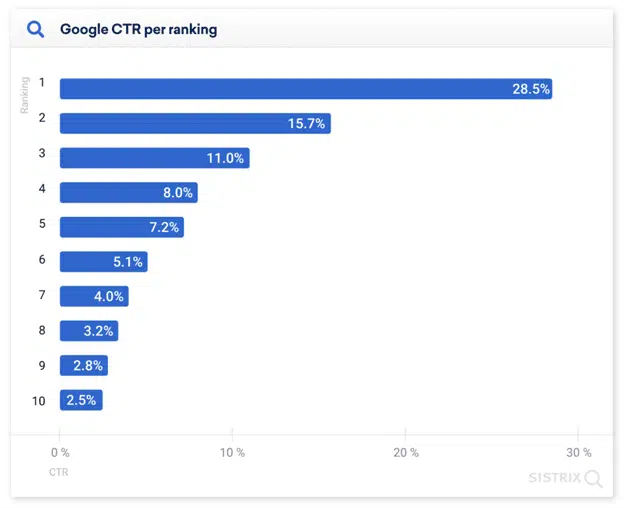
10. SEO is so effective that moving up to a top position on the results page will boost your click-through rate (CTR) by 30.8%. (source)
The higher you move up in the ranks, the more clicks you are more likely to get.
11. About 75% of online searchers never scroll past the first page. (source)
You need the power of both organic and paid search to get a spot on the first page and generate more traffic.
12. In 2021, organic search engine visits increased from 59% to 63%. (source)
13. As of 2023, the search market was estimated to experience a huge shakeup due to the takeoff of many AI-powered search tools. (source)
This is because these AI-powered search tools allow users to dig through information of their interest informally.
14. The click-through rate for long-tail keyword searches is about 3-5% more than generic keywords. (source)
Long-tail keywords are more specific and direct. Internet users want specific results when they search for information.
Aside from SEO, redirecting people from your social media accounts to your website is another way of generating organic traffic. But it is not as effective as SEO.
15. Organic search can boost the business value of a blog by 429% (source)
16. Over 1.7 billion internet users use Google daily. An average user searches on Google 4 times daily. (source)
17. Google’s algorithm uses about 200 factors to rank the quality and relevance of a website. (source)
Google uses these factors to crawl through the content of your website and index it. The factors include:
- Page-level factors
- Backlink factors
- Site-level factors
- Domain factors
- User engagement
- Brand signals
- Both on-site and offsite web-spam factors
18. Organic Search has been said to be the top traffic source for all websites. (source)
19. Over 70% of shoppers purchase online through their mobile phones. (source)
20. The average word count of the results in Google’s SERP is 1890 words. (source)
21. About 70% of consumers focus on the search bar at an online retailer’s site. (source)
Paid Search Statistics
From the latest PPC statistics, you will see how essential paid search ads are for your business. But how does it compare to organic search?
22. According to 49% of digital marketers, organic search brings in the most return on investment (ROI). On the other hand, 19% of digital marketers say it is a paid search. (source)
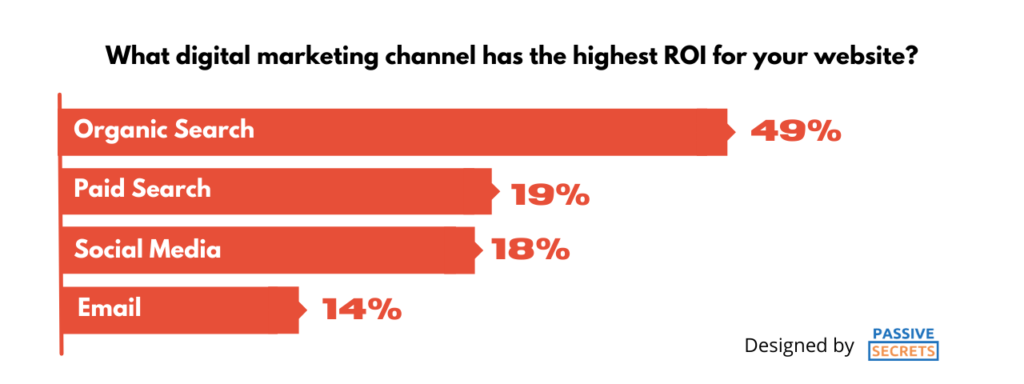
23. In another survey, over 70% of online marketers agree that SEO is a more effective strategy than paid ads. (source)
Most marketers prefer SEO because it is a long-term strategy.
24. Organic search holds over 53.3% of all website traffic. While 15% comes from paid search. (source)
25. Regarding organic vs paid search traffic conversion rate, organic searches are more than likely to get clicked 8.5 times more. Conversely, paid searches are 1.5 times more likely to have search engine conversion. (source)
26. 75% of online shoppers say they prefer search ads because it makes finding the information they are looking for easier. (source)
27. More than 26% of online users click on a paid search ad because it mentions an ad they are familiar with. (source)
28. About 33% of people are likelier to click on a PPC ad because it directly answers their search query. (source)
29. Of the people who click on paid ads, 63% click on Google ads, 14% on Amazon, and 9% on YouTube. (source)
30. In Adwords, the average conversion rate for search is 3.75% and 0.77% for display in all industries. (source)
31. In 2022, Search Advertising spending amounted to $185.35 billion. This figure is expected to increase by 16% annually until 2028, which is close to $261 billion. (source)
32. Google Ad Display Network reaches about 90% of internet users worldwide. (source)
33. Spending on paid search ads rose from $58 billion in 2020 to $144.8 billion in 2021. (source)
This value is expected to rise to $190.5 billion by 2024.
34. From 2020 to 2021, there was a growth rate of 14% in digital marketing budget spending across businesses. (source)
35. The total spending for search ads in the U.S. experienced an 8.9% increase in 2020. (source)
36. PPC returns $2 for every $1 spent, resulting in a 200% return on investment (ROI). (source)
37. Facebook and Google Ads are the top paid ad channels with the most reported ROI rates. (source)
38. When consumers are exposed to display ads, it has been shown that they are 155% more likely to check out a brand’s specific terms. (source)
39. Search advertising spending in the U.S. is expected to surpass $261 billion by 2028. (source)
What is Paid SEO or Search Engine Marketing (SEM)?
For most people, deciding whether to invest in organic or paid search is still difficult. Both traffic generators have their ups and downs. However, intelligent marketers agree that choosing both is the best option instead of choosing one.
Paid SEO, which is also known as Search Engine Marketing (SEM), combines the strengths of both organic search and paid search to create a more effective search strategy.
SEM is like PPC, but it encompasses more than just PPC ads. It uses search engine optimization (SEO) and paid search advertising (PSA).
Powerful SEM Statistics To Improve Your Search Engine Marketing Strategy
40. SEM accounts for 68% of website traffic — Organic search is 40%, and paid search is 28%. (source)
41. More than 75% of B2B traffic comes from both organic and paid search or, rather paid SEO. (source)
42. Companies and marketers that use SEM — combining both SEO and PPC techniques — experience a 25% increase in clicks and a 27% increase in profits. This is compared to companies that use just one strategy. (source)
Both SEO and PPC are good individually. But they are also suitable for specific situations.
For example, SEO is suitable if you have a low marketing budget and if you want the results to last a long time. However, it takes a while before your page or website is ranked.
On the other hand, PPC is suitable if you want to promote a sale-limited offer. Also, you can use PPC if you want a fast ROI and boost brand recognition.
Investing in both techniques is perfect for generating more online traffic to websites.
43. As of February 2022, Google has had over 82.6 billion visits. Before the year runs out, the figure is expected to surpass. (source)
44. About 90% of mobile phone and tablet search traffic comes from Google. (source)
45. 75% of B2B marketers want to generate more leads to attract more traffic to their website. (source)
Most of these marketers prefer to use SEM strategies to achieve this goal.
46. Preference for video content is on the rise, and it is another way of boosting your rankings on search engines. (source)
Including video content on your landing page increases your chances of ranking on Google’s top pages by 60%.
47. As of 2020, over 70% of keyword searches include image results. The number is projected to rise by 2022. (source)
The world can never get over the importance of visual content.
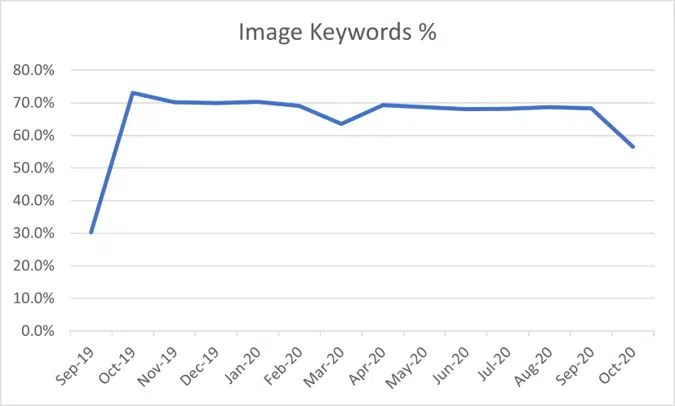
48. Google currently holds over 85.5% of the search engine market share. (source)
This means that Google is the number 1 search engine people go to get information about a product or service.
49. Bing, which is Google’s closest competitor, has a market share of 2.66%. (source)
50. In 2021, Google’s annual advertising revenue was valued at $209.49 billion. (source)
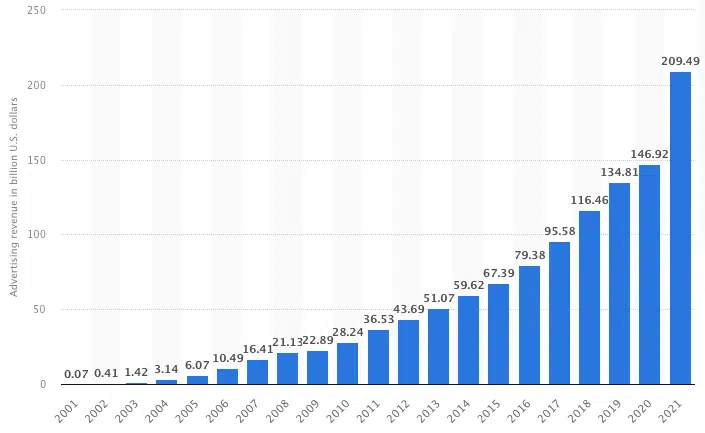
Importance of Using Both Organic and Paid Search
After comparing organic vs paid search statistics, you will see that both digital marketing strategies are vital for the success of your digital marketing plan.
The number of paid search results in search engines SERP has grown, overshadowing the number of organic results on the results page.
When you type in a search query, you are more likely to see more paid ads than organic results. As a result, marketers use paid ads to boost their visibility and increase brand familiarity.
PPC significantly impacts organic results. It impacts the click-through rate of organic results, thus boosting its rank and performance.
1. Stronger Results
When you combine both paid search and organic search, you get to enjoy the best of both worlds in their power. You don’t just increase your awareness, but you also establish yourself as an authority in your industry.
Paid search ads use more CTAs and Conversion-oriented copies than organic results.
2. Consistent Ranking
SEO focuses more on meta description, backlinking, and keyword use (although not so much now) to generate organic traffic.
PPC, on its own, involves paying search engines to sponsor your ads and earn you a new spot on the top positions of the results page.
Both internet marketing strategies are geared towards increasing your ranking.
Relying only on organic search to boost your ranking can be very risky. Organic rankings are very versatile.
One week, a page is at the top position; the next week, it is down three or four positions.
You can use PPC while optimizing for the latest SEO update to secure a top-ranking position.
Integrating paid and organic search strategies in your digital marketing plan widens your business potential of maintaining high status in search engines.
3. Double Visibility and Credibility
You can appear more than once on the results page if you combine both organic and paid searches. This leads to double visibility, greater click-through rates, and more site traffic.
Doubled visibility increases your chances of standing out to potential customers.
PPC ads are targeted, meaning that they attract your ideal audience. Hence, there is a higher chance that this ideal audience will click on your website to get more information on what you offer.
4. Creating Better Organic Content
This is where the benefits of ad analytics come in. Analyzing your paid ads lets you see the ads that are performing well, especially in terms of ad copy.
With this, you can know what ad attracted the most customers. By using this information, you can create on-page content, meta descriptions, and title tags based on the ad copy.
Testing the performance of a keyword or ad copy is effective because you can easily get results quickly. However, relying on just SEO – title tags and metadata – to get results will only take a longer time.
Also, an attractive and compelling ad title and description can clarify your ad’s intent. Optimize the meta tags of your ad pages to attract more clicks.
The title tags and description should answer your audience’s search queries. By doing this, your audience will feel more drawn to your ads. In paid search, SEO elements are also important.
5. Building Stronger Campaigns
Organic and paid search can help to build stronger campaigns by complementing each other and working together to achieve better results.
Organic search helps to build authority and trust over time, and paid search allows you to target specific keywords and audiences to get in front of the right people at the right time.
For example, if you want to rank for a specific keyword, you can create optimized content and then use paid search to promote that content and drive traffic to it.
In combining the two, you can then maximize your reach and improve the overall execution of your campaigns. This is an easier option and a more effective way of creating campaigns.
6. Driving Greater Traffic Towards Your Website
The use of both organic and paid search implies that you’re casting a wider net to capture more traffic to your website.
Optimization of your website through both organic search and paid search is a good strategy to get more traffic to your website. This is because, in doing so, you are also increasing your chances of being seen by potential customers.
Latest Search Engine Marketing Trends in 2024
As PPC ads and SEO trends constantly change, SEM trends also change. For example, SEM campaigns are now based on artificial intelligence (AI), voice campaigns, etc.
1. More Focus on Automation
Google has increased its efforts to limit the number of data advertisers can access and analyze.
Google Ads provides new AI-based learning-powered solutions to automate insights for today’s challenges for innovative marketers who want to establish their analysis.
Because most Google advertisers lack the necessary experience or expertise, the trend toward automated insights will continue as Google introduces new features.
The most important key point to remember is that machine learning is advantageous, and automated bidding can be customized and led in various ways.
Some level of automation is required to keep up with all of the data pointing to bidding decisions.
2. E-commerce Competition will Heat Up
Google Shopping Ads are an innovative way to acquire new customers for your company. Smart Insights says, “Shopping ads account for 76.4% of retail search ad spending.”
According to the latest omnichannel marketing statistics, the rate of online shopping increased in 2022. Therefore, retailers now have a better chance of achieving a breakthrough ROI with Shopping Ads.
As more marketing firms begin to use this ad design, competition will heat up. Google has started making Shopping Ads available to all businesses for free.
“Businesses can compete for Shopping Ad space as they do for other ad campaigns,” Google says.
3. More Use of Non-SEM Tactics
Advertisers face numerous challenges when it comes to managing pay-per-click campaigns. It may also persuade some to spend much more money on non-Google Search Engine Marketing tactics to achieve their objectives.
While Google will remain the most popular search engine, other options will become much more appealing as the platform limits what advertisers can and cannot do.
This is especially true now that search engines like Bing have made it simple to integrate Google Ads campaigns, removing the need for marketers to start from scratch.
Apart from Google, other platforms such as Yahoo advertising, Quora advertising, Amazon advertising, and so on are proving to be beneficial for businesses by allowing them to manage the approach to achieve a higher ROI.
4. Voice Search Can Still Dominate
Text searches are slowly getting old-fashioned. Today’s users are more and more inclined to voice search. This preference coincides with a switch to long-tail or complicated keywords.
Instead of spending time typing long texts, users can easily pose their search query as a question.
Optimizing content for natural language and answering questions people might ask aloud has become a search engine marketing trend as of 2024.
This means using phrases like “how to,” “what is,” and “why is” in your content, as well as focusing on resolving questions that people might ask.
Using a conversational tone in creating your content or campaigns also goes a long way in helping your overall marketing strategy.
5. AI integration will Increase the Daily
AI integration has been seen to encourage effective search engine marketing. A clear example is the use of chatbots.
Chatbots are AI-powered programs that can imitate a typical conversation with a human. They can answer customer questions, provide information about products or services, and even make certain recommendations.
Chatbots are becoming increasingly common on websites and social media platforms. They are one of the tools used in personalizing and enhancing users’ experience.
Additionally, AI is being used to improve search engine ranking algorithms, making them more effective at ranking content based on relevance and quality.
6. Mobile Optimization will be taken more seriously
Mobile optimization is a very serious trend to be taken seriously. This is because users have a limited attention span; hence, it is better to take advantage of the little attention you can get.
Some of the factors involved in mobile optimization include page speed, responsive design, and mobile-first indexing.
Page speed simply means how quickly a website loads on a mobile device. Optimizing for page speed has been proven to improve your website’s ranking.
Responsive design is the practice of developing a website that looks nice and functions well on all devices.
Lastly, mobile-first indexing is simply Google’s way of prioritizing the mobile version of a website over the desktop version for indexing and ranking purposes.
All of these factors help in mobile optimization and in an overall search engine marketing strategy.
7. Local SEO will be more emphasized
Local SEO will be emphasised more in 2024 to improve a brand’s ranking, although many digital marketers are taking advantage of it already.
Utilizing local SEO for your website includes providing detailed and accurate information, such as the business’s address, hours of operation, and contact information.
Adding high-quality images and positive reviews to the listing is also important, as these can also help improve its ranking.
Additionally, using local keywords and building citations on local directories can help improve local search rankings.
Lastly, using location-specific content, like blog posts about local events or news, can also be beneficial.
8. Personalization
As for personalization, search engines increasingly use user data to tailor search results to the users.
These personalized search results are often based on a user’s location, previous search history, and social media interactions.
For example, a user who is located in Europe may see different results than a user in Canada when searching for a restaurant.
Similarly, a user who has searched for information about a particular topic in the past may see related results when searching for something else.
Finally, social media interactions like likes and shares can impact what results a user sees, as search engines continually consider social cues when ranking content.
Start Using Both Organic and Paid Searches
The search engine marketing industry has gotten tougher and more competitive. Everyone is striving for a top-ranking position on the search engines.
The higher you rank, the more recognition your business gets. The best way to be on the safe side is to use both organic search and paid search strengths.
Businesses, especially small businesses, should consider using a blend of both organic and paid search strategies to reach their target audience.
While organic search is important for long-term visibility and building trust with customers, paid search can be effective for generating immediate results.
Tailoring your organic and paid search strategies to your business goals and target audience is vital. While this strategy is cost-effective, it also has guaranteed effects like increased online visibility and more traffic to your website.
